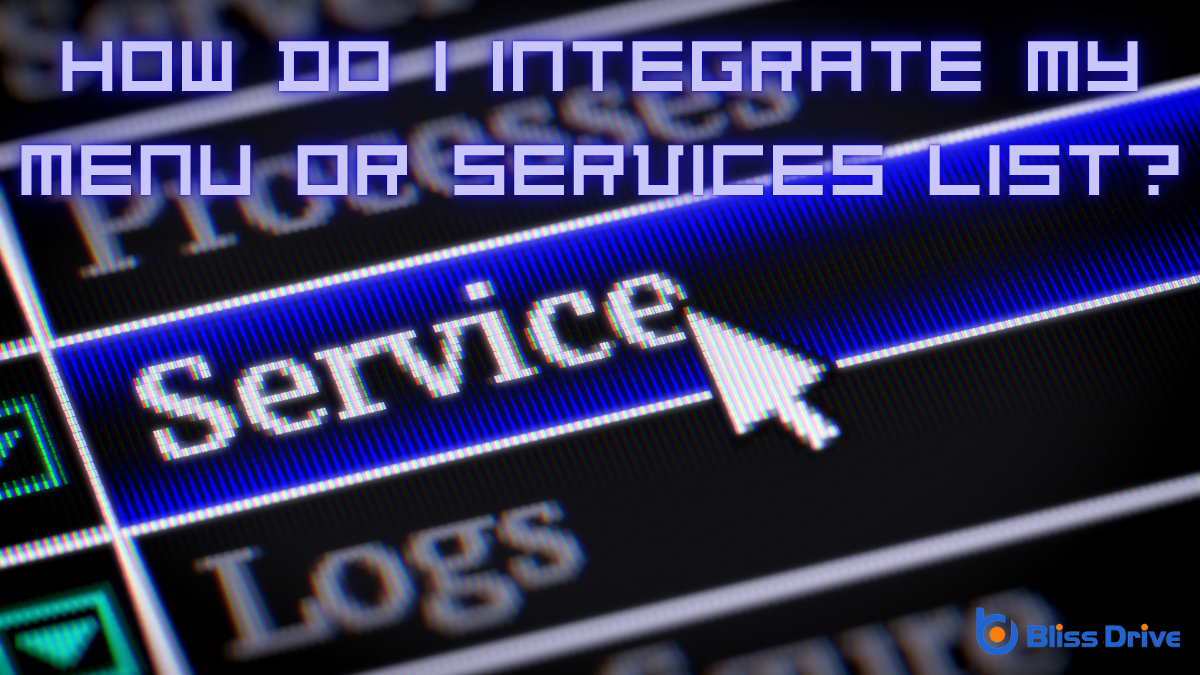Learn More About Us

To integrate your menu or services list, start by identifying your specific needs and choosing the right software that fits your business. Make certain it’s mobile-optimized and compatible with existing systems. Test integrations with third-party platforms to enhance scalability. Automate processes through API integrations for efficiency. Regularly update and monitor trends to maintain relevance and ensure accuracy. Seeking further insights will guide you through the integration process effectively.
How do you guarantee you're picking the best software solution for integrating your menu or services list? Start by identifying your specific needs. Are you looking for a simple, user-friendly interface or advanced features like real-time updates?
Research different platforms by reading reviews and comparing features. Consider scalability—will the software grow with your business?
Evaluate compatibility with your current systems to avoid technical hiccups later. Don't overlook cost; ascertain it aligns with your budget without sacrificing essential functionalities.
It's also wise to test any free trials or demos to get a feel for the user experience. By taking these steps, you'll make an informed decision that enhances your operations and meets your customers' expectations effortlessly.

Once you've chosen the right software, it's time to set up your digital menu or services list. Begin by organizing your items into clear categories—think appetizers, mains, desserts, or various service types. Input each item’s name, description, and price, confirming accuracy. Use engaging, concise language to make your offerings appealing. Include high-quality images where possible, as visuals often enhance user experience and decision-making.
Next, prioritize user-friendly navigation. A well-structured layout helps customers find what they're looking for quickly. Consider adding filters or search options to improve accessibility.
Also, regularly update your menu to reflect seasonal changes or promotions. Finally, test the digital menu on different devices to verify it displays correctly, guaranteeing a seamless customer experience.
When you're optimizing your menu or services list for mobile, it's essential to guarantee a responsive designA web design approach that makes web pages render well on a variety of devices and window or screen ... that adapts to different screen sizes.
Make the navigation touch-friendly so users can easily tap through options without frustration.
Don't forget to focus on fast loading speeds to keep your audience engaged and prevent them from bouncing away.
In today's digital age, guaranteeing your website's menu or services list is optimized for mobile devices isn't just a bonus—it's essential. A responsive design adapts to any screen size, providing a great user experience.
Here's why it matters:
Maneuvering a website should be a breeze, especially on mobile devices where touch-friendly design is essential. When integrating your menu or services list, make certain buttons and links are big enough for fingers to tap easily.
Avoid cramming too many options into a small space, which can frustrate users. Instead, use expandable menus or collapsible sections to keep things tidy and accessible.
Prioritize a simple, intuitive layout. Users should instantly understand how to find what they need without pinching, zooming, or hunting around.
Incorporate swipe gestures for smooth navigation between sections, enhancing the user experience. Don't forget to test your site on various devices to make certain it functions well across the board.
With these steps, your mobile visitors will enjoy a seamless browsing experience.
How essential is fast loading speed for mobile optimizationDesigning and formatting web content to ensure it performs well on mobile devices.? It's vital. Users expect instant access to your menu or services list, and slow loading times can lead to frustration.
Here’s how you can guarantee fast loading speeds:
To streamline platform connections, consider integrating your menu or services list with third-party platforms.
By leveraging API integration, you can benefit from improved efficiency and real-time updates.
This approach guarantees that your data syncs seamlessly across all platforms, providing a smooth experience for your users.
Although it might seem intimidating at first, integrating with third-party platforms is a strategic move that can considerably streamline your operations. By connecting your menu or services list to external systems, you guarantee a seamless flow of information.
Here's how you can start:
Connecting your menu or services list to third-party platforms isn't just about streamlining operations; it also opens up a host of benefits through API integration.
By leveraging APIs, you can automate updates, ensuring your offerings are always current across multiple platforms. This reduces manual errors and saves you time.
APIs also allow for better customer interaction, as they can access real-time information, enhancing their experience. Additionally, integrating with popular platforms can expand your reach, attracting new customers who mightn't have found you otherwise.
APIs provide analytical insights, helping you understand customer preferences and make informed decisions. Embracing API integration not only simplifies processes but also drives growth by keeping your business agile and responsive in a digital world.
Seamless data synchronization with third-party platforms transforms how you manage your business's menu or services list. By integrating these platforms, you guarantee real-time updates and consistent information across all channels.
This approach offers several benefits that streamline your operations:
With these strategies, you'll keep your business efficient and responsive, guaranteeing you meet customer expectations effortlessly.

When you implement automationUsing software to send emails automatically based on predefined triggers and schedules., your operations become more efficient, allowing you to focus on what truly matters—providing excellent service.
Automation streamlines your menu or services list integration by reducing manual tasks and minimizing errors.
Imagine updates happening in real-time; prices, descriptions, and availability are always current without you lifting a finger.
This efficiency saves time and guarantees you’re always presenting accurate information to your customers.
To keep your business running smoothly, it’s essential to regularly update and maintain your menu or services list. This guarantees customers have the most accurate information and helps you stay competitive.
Here’s how you can keep your list fresh and relevant:
Incorporating a digital menu or services list into your business can transform your operations and customer experience. By selecting the right software, ensuring mobile optimization, and integrating with third-party platforms, you’ll streamline your processes and enhance accessibility. Automation will save you time, while regular updates keep your offerings fresh and relevant. Embrace these steps, and you'll not only simplify your workflow but also elevate your customer satisfaction, driving your business forward.
